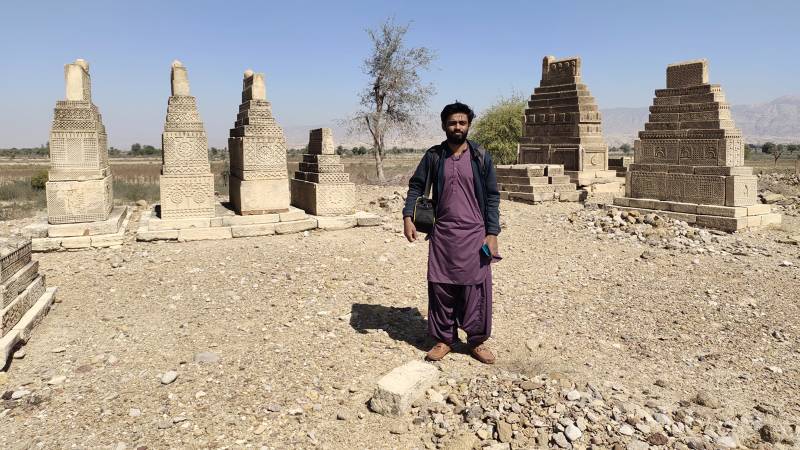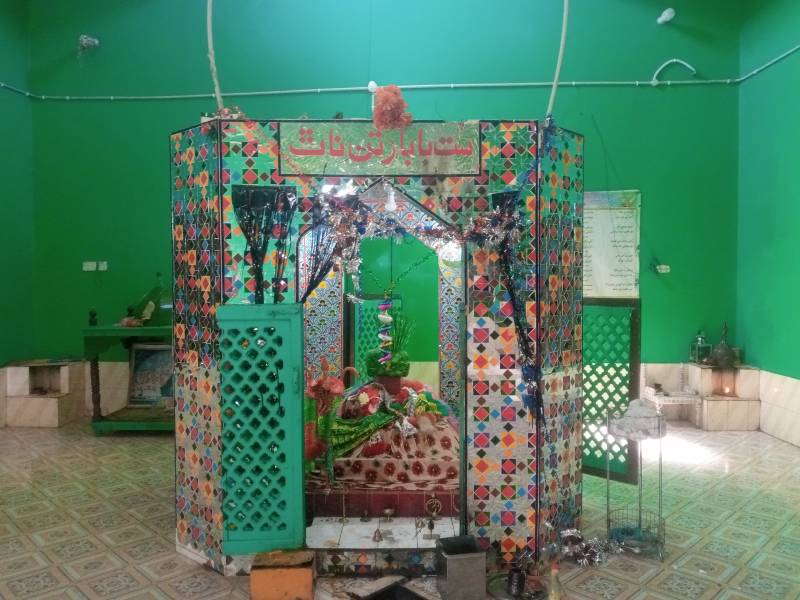
One morning, we embarked on an expedition to explore Kohistan –rugged terrain once inhabited by humans predating the mature Indus civilisation. While the region encompasses the districts of Jamshoro, Dado and Kamber in Sindh, our focus was specifically on Jamshoro. Our journey commenced upon crossing the M9 Motorway, halting at ‘Dadabhai’ where Rehan Palari awaited us on his motorcycle. With warm greetings exchanged, we set out for Saari Kohistan.
Near the cement plant, a prominent sign advertised the activities of Rumi Builders, encroaching upon indigenous lands and encroaching upon the scenic Kodhiri Mountain with the aid of local brokers.
Near Kodhiri Mountain lies the venerable Tak Makan cemetery, one of the oldest Necropolises dating back to the 12th century. The grand tomb of Piraro Palari, erected in the same era, points us the region’s past, although historical records of Piraro are sparse, with the burial marker being a ‘Nithalo.’
According to local Kohistani resident Khuda Bux Wakijo, legend suggests that a ‘Nithalo’ consumed a meagre "man" equivalent to a fraction of black peppercorns to construct this Necropolis, with a small pot nearby. The narrative is shrouded in the ambiguity of myth and reality. Upon uncovering a dated inscription on a stone, its origins are inferred to trace back to the 12th century. Situated four kilometres from the M9 motorway, Tak Makan welcomed our arrival, leading us to the ‘sarri’ in the town where Rehan's drawing room awaited. After a brief break for tea, we proceeded to the megalith or stone henge along the Sarri-Mol Road, traversing Mater Lake and relishing the panoramic vista from the mountain's summit.

Yaqub Village revealed a henge or megalith comprised of no more than 6 or 7 stones, dating back to the Iron Age and likely utilised for religious ceremonies. En route to Mol Sharif, our journey extended over 10 kilometres, where the well-known tolerance of the locale was indicated by the presence of a Mandir of Jhulelal, hosting grand commemorations such as the Chetichan Melo and Matas anniversaries.
Our path intersected with that of Comrade Ghulam Muhammad Hasrani, who, guided by Rehan's familiarity with the terrain, entrusted his son Amar to lead us to the peak where women's graves lay. Passing the Mol River before our arrival, we noted the desolation wrought by mining activities, severely impacting the river's ecosystem as a tributary of the Malir River. Continuing northward for 5 kilometres, we encountered "Kopu" Mountain, facing Mehr Mountain, where despite our weariness, the breathtaking scenery rejuvenated our spirits, beholding the expansive walls of Bahria Town. Rehan informed us of Bahria Authority's encroachment onto Mehr Mountain, underscoring the broader significance of the Kohistan mountains within the Kirthar Mountain Range. As development activities encroach upon Kirthar National Park, threatening its cultural legacy and environmental integrity, the urgency of preserving this natural and historical treasure becomes greater than ever.
Our journey was full of adventure and learning opportunities, revealing archaeological sites and natural features alike - graves, pyramids, springs and other aspects of Kohistan's heritage
We stumbled upon the women's burial site, where Ghulam prepared a meal. As the sun dipped behind the mountains, signalling the onset of evening, people gradually began their journey homeward, leaving us to marvel at the beauty of the location. The next day, our expedition resumed in the early morning, heading towards Taung Sharif and Kerchat refuge. Eventually, we traversed "Meter Lak" and continued to "Esar Lack," passing through "Rek" to reach Taung. There, instead of the solemn Necropolis of Jam Lohar cemetery, I beheld the magnificent spectacle of mountains.
Taung holds a special significance, being one of the most captivating sites that I have ever encountered. Kohistan is renowned for its awe-inspiring mountains such as Kambu, Halar, Kirthar, Spring, Pyramid, and Graves in Taung—a remarkable testament to Sindh's cultural heritage. These graves, nestled in the quaint town of Taung, Thana Bola Khan, Jamshoro, are surrounded by prehistoric sites, springs, and scattered tombs. Adorned with depictions of swords, weapons, horseback riders, and intricate jewelry designs featuring peacocks and serpents, they stand as unique relics. Notably, the Balustrade found here is a rare sight, as the Tak Makan cemetery remains the sole location in Sindh showcasing such imagery.
Archaeologist Bokhari Hakim Shah and anthropologist Zulfiqar Ali Kalhoro conducted the initial studies, revealing around 350 Rumis, ranging from 4 to 18 feet in height. The area hosts four graveyards locally referred to as Tuang Tombs, steadfastly preserving its heritage against external influences. Malik Pahar, a prominent historical figure of the Burfat lineage, asserted his dominance over Sindh-kohistan and Lasbela. Although he attempted to extend his rule to Kacho, he was defeated by Mian Yar Muhammad Kalhoro in 1705. Nonetheless, Mian Yar Muhammad Kalhoro granted him some 'jagir'. Upon Malik Pahar's demise in 1741, his widow Mai Chagali assumed leadership over Sindh-kohistan and Lasbela, marking a pivotal moment in the region's history.
The people of Taung are renowned for their valour as they waged guerrilla warfare against the Arghuns and Mughals. A resident told us of a spring in Taung that feeds over 10,000 acres of land. Notably, a temple dedicated to Baba Rathan Nath draws devotees from far and wide, revered by Muslims as Ranthan Shah, with the descendants of Jam Lohar tasked with its upkeep.
Another notable site is the man-made pyramid known locally as "Meeri Je Bhuthi." Our journey continued towards the Kerchat sanctuary, navigating the rugged expanse of the Kirthar Mountains. Upon reaching Kerchat refuge after a challenging trek, we found it devoid of animals, prompting our onward journey to Sarri.
Our journey was full of adventure and learning opportunities, revealing archaeological sites and natural features alike - graves, pyramids, springs and other aspects of Kohistan's heritage. The warmth and dignity of Kohistan's inhabitants left a lasting impression, their assistance proving invaluable in our exploration. Amidst the election season, PPP flags adorned the landscape, signaling the political landscape. However, concerns loom as the PPP government, alongside Bahria Town and other major projects, encroach upon the pristine landscapes of Kohistan, exacerbating environmental degradation through deforestation and river mining.
Yet, amidst these challenges, we hold the responsibility to safeguard our rivers, protect our environment, and preserve the sanctity of Kirthar National Park.

